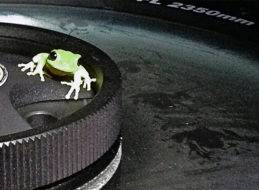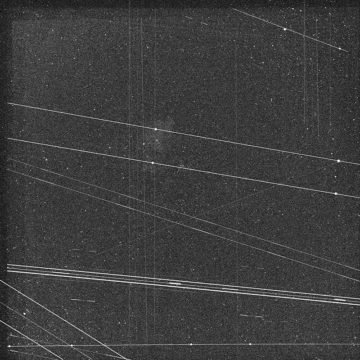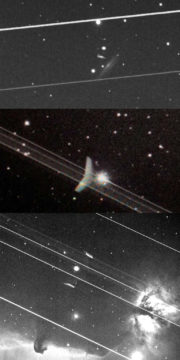Unexpected vibrations, airplanes, and satellites can photobomb your exposures without you knowing it.

Richard S. Wright Jr.
Most of what we astrophotographers do happens at night. As the dark descends, the world goes still. Tranquility pervades as our gear clicks away undisturbed, gathering ancient photons from the heavens.
Yeah, think again! Things happen in the dark while you’re away sleeping. Lots of things.
Bad Vibrations
Years ago, I was testing the new Paramount MX for my employer, but for months, I struggled with a vexing problem. About once an hour one of my exposures had a sudden “wiggle”, almost like someone bumped the mount violently. If I didn't know better, I would have sworn a band of raccoons were showing up for a party at my telescope as soon as I went in the house. Instead, I blamed the mount itself. I spent an undue amount of time trying to diagnose some kind of mechanical problem, annoying both me and my boss who was trying in vain to help me diagnose the issue.
One night, I was still sitting mount-side when the central air-conditioning unit came on. There came a big "rumble rumble," and I saw the guider graph go nuts. I could feel vibrations through my feet — and through the concrete beneath them — from the AC unit that was at least 30 feet away. Inconceivable! Living in Florida, it wasn't uncommon for the AC to turn on and off many times throughout the night. Ultimately, I had to add "turn off the AC" to my imaging routine. (This did not fly well with my wife when I sometimes forgot to turn it back on in the morning, but that’s another story.)

Richard S. Wright Jr.
So when things are going well and suddenly you get something intermittently weird in your images, it's not always an equipment malfunction — be sure to consider environmental factors, too.
A second common nemesis is cable drag. A cable hanging off of your mount will drag along the ground as the mount rotates tracking the sky. The mount is moving very slowly, so if the cable gets momentarily stuck, it will take time for the tension to build up. Eventually, the tension becomes strong enough to pull the cable loose from whatever was hindering it and it slips along the ground. The tension is released, and “boing” goes your mounts' tracking.
Night Lights
I've been imaging for quite a few years, and I'm often asked to look at raw images to diagnose problems. Often, the question is about strange lights in the image. “Hey Richard, what causes this?” “What the heck is this thing?” No, it’s not an alien invasion. Even before the launch of Starlinks, there have been a lot of things flying around in the sky.

Richard S. Wright Jr.
An airplane flying through your field of view will leave bright lines in your image. These may appear as a single line, a pair of lines, or a set of three.
Look at the rejection map image above. This image shows all of the pixels that were rejected from individual exposures as part of a imaging software's statistical analysis. The original image of M42 contained a couple of hours' worth of exposures of M42. Airplanes created many of these streaks.
But airplanes aren't alone in lighting up the sky. Geosynchronous atellites created the faint vertical lines in that image. And many, many more low-Earth orbit satellites will be filling the sky soon.
A friend at a star party came to me and showed me faint lines like these. He thought it might be a bug in my new camera plug-in that he was using. “Those are geosynchronous satellites, they're really common in that part of the sky,” I told him. He looked at me skeptically. “I’ve never seen those before,” he said. Well, we're all going to see them all the time real soon.
Fortunately, for most deep-sky photographers, there's course of action. In fact, anyone who has imaged near an airport already knows what to do about the coming onslaught of satellite trails: remove them.
My favorite thing to watch for, though, is when an airplane's blinking lights strobe its engines or wings, like in the image just above. No, that’s not a UFO! Think about it: The camera shutter was wide open and the plane flew through. While there wasn't enough light to see the engines for most of the exposure, the plane's lights momentarily flashed and strobed the engines. For just an instant, the engines are lit up, and your very sensitive astronomical camera can see them plainly. Sometimes the lights will light up the entire wing!
These are of course just a few examples of a myriad of things that photobomb your long, carefully tracked exposures. If you have your own stories, feel fr
 0
0









Comments
Tom-Fleming
February 19, 2020 at 6:57 pm
I shoot thousands of exposures to capture random fireballs. Frequent fliers (and infrequent) on my images.......... fireflies, flaring satellites, paired parallel light sources, cosmic rays, tumbling sats.
The flaring satellites look a lot like short path meteor burns.
You must be logged in to post a comment.
You must be logged in to post a comment.